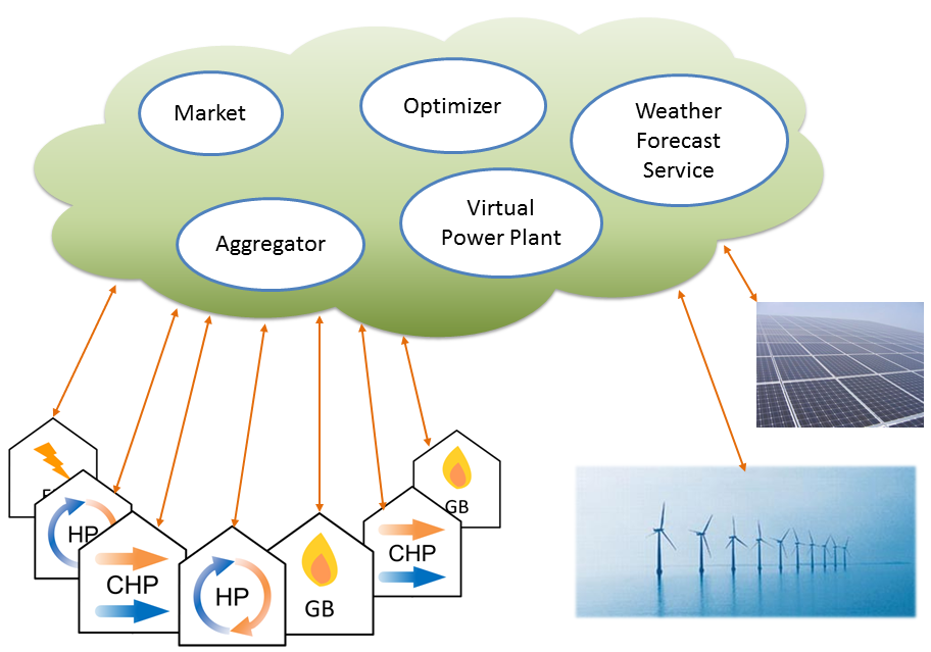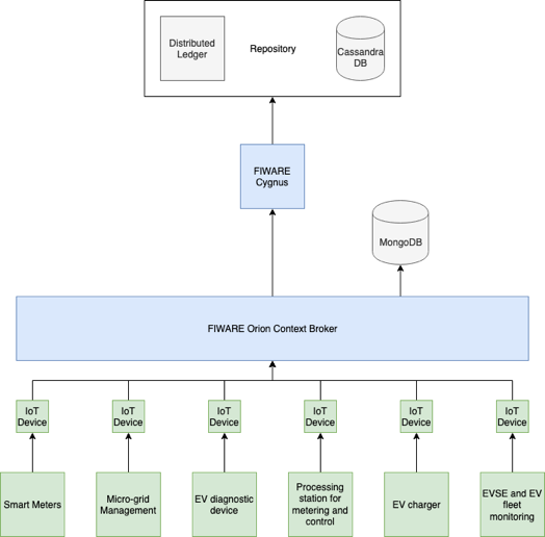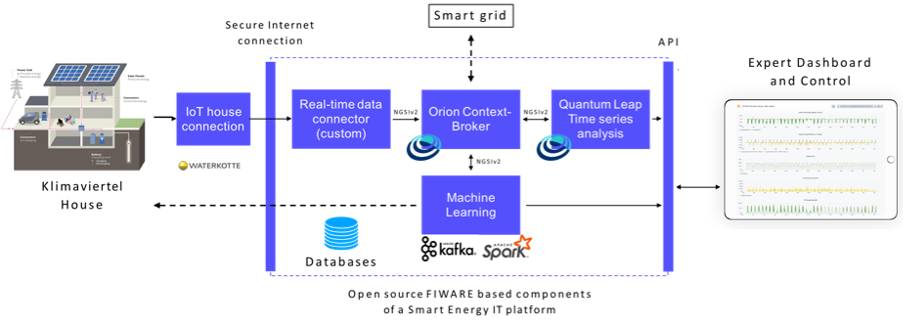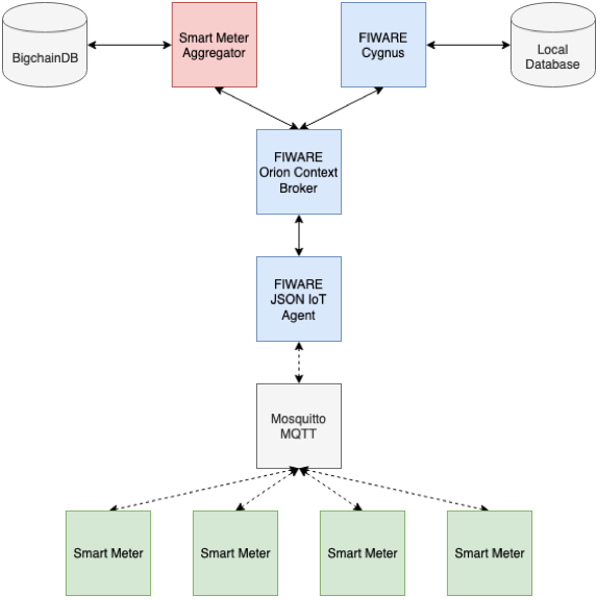Challenge & Context
In December 2019, the European Commission launched the European Green Deal, designing the path for Europe to become the first climate-neutral continent. At the centre of the strategy is the understanding that any ambition for a positive impact on climate and the environment needs to be closely matched by economic measures to assure the well-being of European citizens and the success of its economy. The “electrification” of our societies (together with a reinforced focus on renewable energy sources) is seen as a way to build both a new “industrial revolution” and strong economies across all of Europe.
This can also be seen as a confirmation of how rapidly the world of energy is changing and the implications of such changes, not only on the economies and our societies but also on the way we live, do business and interact with the environment.
In this context, FIWARE technologies have been used in the last few years to experiment on solutions to empower the role of “local energy communities”, also called “prosumers”. Being a portmanteau of the words provider and consumer, a prosumer is an individual who both consumes and produces. This new category of “prosumers” in the energy marketplace can have a significant impact on the achievement of the climate neutrality objectives set by the European Union and the future economic development of its Member States FINESCE (Future INtErnet Smart Utility ServiCEs).
Introduced by the 2019 EU Electricity Directive, which requests that legal and commercial barriers to the participation of consumers to the energy markets should be removed, “local (or “citizens’, as they are often called) energy communities” could change the way through which energy is a) produced, b) transmitted, c) distributed and d) used.
Various research initiatives across Europe have been developing and testing architectural models and use cases enabling communities to target energy autarchy, improved flexibility, or developing local energy marketplaces by leveraging FIWARE technology. Several platforms (e.g. FISMEP) and services have been validating new use cases, and the added value provided by FIWARE Context Broker and other FIWARE generic enablers acknowledged by some of the most renowned experts in the development of microgrids services and energy efficiency.
While technological innovation, supported by the FIWARE Community, helps to address resilience, affordability and vulnerabilities within the energy sector, the combined bottom-up pressure from urban authorities and the top-down push from national regulators could, in the near future, be of extreme benefit. This could indeed support the changes deemed necessary to revolutionise the energy sector, fastening and helping scale-up the transition process to new digital infrastructure management and business models.
Solution
The use of FIWARE generic enablers has been shortening and streamlining the development of solutions to support “microgrid services” and enabling “citizens energy communities” already for time, in particular supporting the development of local energy marketplaces. These generic enablers help implementing monitoring systems for “self-sufficient” energy districts (i.e. implementing concepts of energy autarchy) or integrating systems of different service providers with applications to consume new market services.
One example of such approach is the FINESCE Marketplace, which involves a consortium of dozens of energy companies, R&D centres, and universities from all over Europe, with the aim of providing an electronic marketplace for electricity closer to new categories of “prosumers”.
In the course of the project, FINESCE partners have recognised that a common, Open-Source platform architecture is better suited to the Smart Energy domain than a siloed approach and that FIWARE can act as the basis for such platform.
The revolution represented by the use of an open Smart Energy Platform concept represents the implementation of a new concept of a utilities marketplace driven by services (named by the project consortium “Utility 4.0”, as it may represent a new, revolutionary “bottom up” approach and a development of the traditional business model of utilities).
Figure 1 . Solution
The active and successful participation of startups to the project has been an effective way of demonstrating how this “service”-based open marketplace, focused on the possibility to integrate new services provided by new categories of prosumers, can better represent the future of a world of energy supply dominated by renewables and clean energy.
How it works
Continuing our excursus on how FIWARE technologies can enable citizens’ energy communities by leveraging blockchain technology, the eDREAM (Innovative Demand Response Technologies for a decentralized energy ecosystem) Project (funded under the Horizon2020) is developing and validating a secure, decentralised, tamper-proof and transparent pool for energy data. Due to the rapid growth of Distributed Energy Sources (DRES) across the globe, the need for a visionary, decentralised approach towards clean energy production and distribution has been addressed by leveraging on the Context Broker at the centre of these processes.
Figure 2 . Architecture
Thanks to a specific component called the smart-meter aggregator, energy data are transferred via the Context Broker to retrieve, translate and store the data into “BigchainDB” (blockchain database), injecting near real-time data into the big data layer used to develop the clustering techniques for load, profiling and customers segmentation and to achieve the following three objectives:
- near real-time control and supervision of grid management and operation at all voltage levels;
- turn traditional, centralised market approaches and smart grid operations into novel, decentralised and community-driven energy systems;
- introduce new marketplace models, adopting distributed ledger technologies for near-real-time closed loop ecosystems, making optimal use of blockchain-based Demand-Response processes.
Thanks to the use of FIWARE Open Source technologies, the eDream project has allowed developers to rely on effective “community” support and reduced the total cost of the technological infrastructure.
Another important example of how the Context Broker can quickly enable the deployment of an infrastructure to support a local energy community is the KlimaViertel in the German city of Herne in North Rhine-Westphalia (NRW). This project, associated to an initiative funded by the European Union and the European Regional Development fund for NRW, is the result of a cooperation between Stadtwerke Herne (the local utility of the city of Herne), Accelogress and Waterkotte and had the ambition to connect and monitor the energy production and consumption in a real-life living lab composed by a number of energy autarchic buildings.
The architecture, designed to integrate the various data sources, leverages FIWARE Context Broker as a data aggregator. In addition, Grafana (a multi-platform open source analytics and interactive visualization web application) has been used to develop a series of dashboards to present a real-time overview of the actual energy production and consumption.
Figure 3 . Functionalities
Benefits & Impact
The use of the open API-based architecture provided by FIWARE has been providing to developers and industry players a number of specific benefits (both in terms of technology advancements and contribution to the exploration of possible new business models), but it has also helped the FIWARE Open Source community to better tailor some of the “Generic Enablers” to support the development of energy applications.
In particular, the use of FIWARE technologies has been instrumental in assessing the real impact of “System of Systems” approaches applied to local energy communities and marketplaces.
In the context of the European project SOFIE (which stands for “Secure, Open Federation For Internet Everywhere), a marketplace, where consumers can search for “clean energy” offers, as well as monetise their “spare” electricity, it has been developed an integration data model coming from a number of different service providers building new services on the basis of the collected data streams.
Coordinated by a consortium of enterprises, research centres and universities, project SOFIE is currently experimenting in particular on ways to use Electrical Vehicles (EV) to decarbonise cities, turning electrical cars into “mobile rechargeable batteries” (this approach is generally indicated as “vehicle-to-grid”, or V2G), instead of relying exclusively on EV charging stations, with the ultimate goal of building a trustworthy marketplace that enables new business models leveraging on data exchange between different parties by setting the security framework for connecting and enabling automatic discoveries of other participating devices. The Context Broker is once again at the centre of the action as it integrates and enhances the interoperability of the different systems involved, creating a standardised platform (“System-OfSystems” approach) to manage, process, and analyse the energy data received.
Figure 4 . Architecture
The architecture and the supported use cases of SOFIE are being validated in a pilot involving an Italian Distribution Systems Operator (DSO – ASM Terni) and a Fleet Manager (Emotion), with a user base of circa 100 end users.
Added value through FIWARE
The use of various FIWARE Generic Enablers to build the foundation for the innovative solutions mentioned above are a clear demonstration of the flexibility and powerful scalability of FIWARE Open Source technologies in addressing the requirements of this new category of prosumers operating in the energy marketplace.
The applications needed to implement the revolution of the energy sector based on renewable energy sources and new energy generation technologies, require at their core a powerful “engine” like the FIWARE Context Broker that aggregates data from a variety of sources and packages it in a way that allows utilities and energy operators to work with information that’s already filtered, organised, and properly labelled.
Several research and innovation initiatives have demonstrated how, leveraging on the FIWARE Context Broker, data from power-plants, energy “smart-meters”, weather forecasts, and other sources, can be aggregated and produce the most up-to-date “intel” of the context they are operating into, to energy producers and consumers.
The FIWARE Context Broker offers a range of advanced functionalities, such as updates, queries, registrations, subscriptions and notifications, helping users retrieve, discover and access information as needed, leveraging it to implement new services and supporting innovative business models.
In addition to this, the FIWARE Context Broker, through its “publish and subscribe” system, allows to publish data from different categories of IOT devices and send notifications when any of the monitored conditions change, allowing, at any given time, operators to act quickly according to their fluctuating energy demands, drastically improving the quality of the services provided to the marketplace.
Next Steps
With the support of the FIWARE Smart Energy Mission Support Committee (MSC ENERGY), the FIWARE iHub IDEASFORUM (through its Smart Energy Competence Centre), is coordinating the drafting of a white paper channelling various project scenarios for Local Energy Communities, looking at different geographical (villages, small cities, city districts, etc.) and business dimensions (e.g. industry/manufacturing, retail, sport or educations districts), in order to capture the interest of regional and national authorities and build momentum in the request to develop projects to empower this new category of players in the energy market
In addition to this, to assure a tighter integration with national and regional smart grids, the members of the MSC Smart Energy of the FIWARE Foundation and the IDEASFORUM Smart Energy Competence Centre will continue to work to establishing a stronger relationship with the working groups at the Linux Foundation for Energy Program (LFE), with particular focus on data architectures, cybersecurity and the use of NGSI-LD to create the integration between different energy systems.
This work is fundamental to enrich the set of tools available for developers in the FIWARE Community in order to assure that new applications developed support “Local Energy Communities”. It also adds to a security by design DNA able to keep them safe through state-of-the-art-security features and principles.
Next steps will be led by the MSC in Smart energy include :
- standardization of Smart Energy services based on FIWARE component;
- evaluation of SAREF data models;
- consolidation of the the relationship between DG energy and Connecting Europe Facility ( Success Story was published by Connecting Europe Facility in November 2020);
- continuous support to the FIWARE Community in the developing solutions to implement new concept of “local energy communities”;
- definition of the FIWARE Architecture for new Smart Energy Marketplace
- to link Smart Energy with e-mobility.
- monitoring of the evolution of Big Data and IoT.
Last, but not least, Smart Energy is a cost-effective, sustainable and secure system in which renewable energy production, infrastructure and consumption are integrated and coordinated through energy services, active users and enabling technologies.
Initiatives and projects that will focus on these specific concepts are following up with FIWARE’s MSC.
References
- Success Story published by Connecting Europe Facility, November, 2020
- White Paper: Expanding the Scope of CEF Digital to the Smart Energy Domain, FIWARE Foundation (Smart Energy Mission Support Committee, Dec 2019)
- The National 5G Energy Hub, 2020
- Compile Project: Energy Community Definitions — Explanatory Note, Roberts, Frieden, d’Herbemont, May 2019
- An open IoT platform for the management and analysis of energy data F. Terroso-Saenz, J. González-Vidal, P. Ramallo-González, F. Skarmeta, Department of Information and Communications Engineering, Computer Science Faculty, University of Murcia, Spain, March 2015
- Statistical Analysis of Prosumer Behaviour in a Real Distribution Network Over Two Years, T. Bragatto et al., 2018




